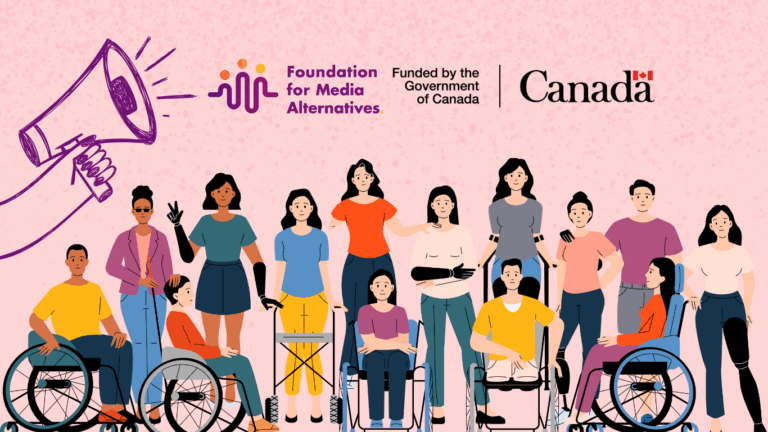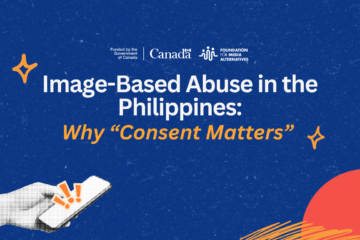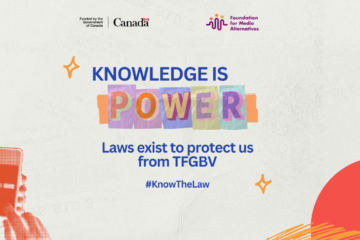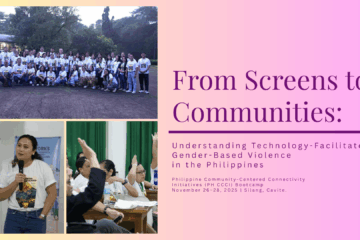Why Digital Security is a Feminist Issue for Women with Disabilities
Published by Foundation for Media Alternatives (FMA) on

Why Digital Security is a Feminist Issue for Women with Disabilities
In today’s connected world, going online isn’t just a luxury but a lifeline. From messaging apps and social media to telehealth and education, digital tools help us work, connect, and express ourselves. But for many women with disabilities, the internet can also be a space of risk, surveillance, and silence.
We often hear about digital safety in the context of passwords or scams. But the conversation needs to go deeper. Digital security is a feminist issue and it becomes even more urgent when we include the lived experiences of women with disabilities.
Excluded and Exposed: Why the Internet Fails Women with Disabilities
Women with disabilities live at the intersection of multiple and overlapping forms of discrimination such as sexism, ableism, and often poverty or isolation, that compound their risks and shape their digital experiences. These intersecting barriers does not only limit access to technology; they also amplify exposure to harm. In online spaces, where power and accountability are often uneven, women with disabilities are disproportionately targeted by technology-facilitated gender-based violence (TFGBV) such as harassment, exploitation, surveillance, and the non-consensual sharing of private information.
Their lived experiences reveal how exclusion and inaccessibility deepen vulnerability. A blind woman who must rely on a sighted person to report online abuse risks losing her privacy in the process. A deaf woman who tries to report harassment may find that a hotline lacks a sign language interpreter or text option. A woman with limited mobility may be unable to complete multi-step verification to block a threat in time. These stories illustrate how systems built without accessibility in mind can unintentionally endanger the very people they claim to protect.
The consequences are not just technical but deeply personal. Perpetrators often target women with disabilities because they believe they cannot defend themselves or that their reports will not be taken seriously. Many survivors face disbelief, dismissal, or inaction from authorities and online platforms, leading to fear, isolation, and silence. Including these lived experiences is essential not as anecdotes, but as evidence of systemic failure. They remind us that digital safety cannot exist without accessibility, accountability, and the voices of women with disabilities at the center.
Safety by Design – Unless You’re Disabled!
Most digital safety features are created with an “average” user in mind, typically someone sighted, hearing, literate, and able-bodied. But what happens when a woman can’t read the small text of a warning? Or when she uses a screen reader that can’t navigate cluttered websites or broken code? Or when there’s no sign language video for reporting abuse? For women with visual, hearing, intellectual, or psychosocial disabilities, these barriers are not inconveniences, they are life-threatening design failures that exclude them from protection. Without accessible interfaces, emergency alerts, or help systems, they are more exposed to online harm and less able to escape it.
Not Just Helping Hands: When Support Becomes Surveillance
Many women with disabilities rely on caregivers, family members, or third parties for access to mobile phones, computers, or even social media accounts. While this support can be helpful, it also creates power imbalances where privacy is compromised and abuse can flourish unnoticed. A caregiver might monitor messages, restrict access, or use a woman’s account without her consent. In some cases, digital tools become another site of control, used to limit autonomy, monitor behavior, or isolate the person further. And because the abuse may be happening within intimate or caregiving relationships, it’s even harder to report, especially if reporting could result in losing one’s only support.
When Inclusion Fails: What FMA Reports Reveal About Digital Harm
In the Philippines, the challenges faced by women with disabilities in digital spaces are intensified by deep-rooted digital inequality. Poor infrastructure, expensive mobile data, and the lack of disability-inclusive digital tools mean that many women with disabilities are excluded from safe and meaningful online participation. For those who do manage to access the internet, support systems are often out of reach. Gender-based violence or any related hotlines may not accommodate deaf women or those with speech and communication impairments. Reporting abuse often involves navigating complex legal forms, inaccessible websites, or non-adaptive systems and these barriers silence and isolate survivors rather than support them.
While law enforcement agencies are expected to respond to such cases, many still lack the training, tools, and inclusive protocols necessary to handle incidents involving women with disabilities effectively. As a result, justice remains out of reach for those who need it most.
Despite growing recognition that digital safety is a fundamental human right, women with disabilities remain on the periphery of online protection efforts. According to the Foundation for Media Alternatives (FMA), a leading digital rights organization in the Philippines, existing systems fail to adequately protect those at greatest risk. In its Filipino Women’s Digital Agenda: Policy Brief, FMA underscores the unequal access to technology and digital literacy across the country. Women with disabilities often face multiple, compounding barriers: limited access to assistive devices, unstable internet in rural areas, and a lack of inclusive digital education. Many express concern over online surveillance, data privacy, and harassment, but find few tools designed with their needs in mind.
This kind of systemic exclusion is not just a technical gap–it is a gender and disability justice issue. Until digital spaces are intentionally built to be inclusive and accessible, even the most well-intentioned platforms will continue to leave the most vulnerable behind.
CTRL + ALT + INCLUDE: Rebooting Digital Safety for All Women
Women with disabilities deserve the same level of safety, respect, and freedom in digital spaces as anyone else but current systems continue to fall short. Many online platforms and reporting mechanisms remain inaccessible by design, making it difficult for deaf users to report abuse or for those with visual, mobility, or cognitive impairments to navigate privacy settings, verify accounts, or seek help independently. Without tools that reflect their realities and without their direct participation in shaping digital policies and platforms, efforts to address technology-facilitated gender-based violence (TFGBV) remain incomplete.
Beyond the lack of accessibility lies the daily strain of access fatigue, the constant emotional and cognitive exhaustion of navigating systems never built with disabled users in mind. Each inaccessible form, app, or website becomes another reminder that inclusion is still an afterthought. Yet accessibility is not a luxury or a convenience. It is protection. When digital environments are designed to be accessible, women with disabilities gain the power to report abuse, seek help, and safeguard their dignity and autonomy without relying on others to mediate for them.
True digital safety can only be achieved when accessibility is recognized as a fundamental right when systems are built to include, listen to, and protect everyone, especially those most often left out.
A Safer Internet for All
Digital security is more than protecting data. It is about safeguarding dignity, autonomy, and freedom. For women with disabilities, reclaiming safety online is not merely a technical goal but a continuation of the broader struggle for rights, visibility, and recognition.
To truly build a safer and more inclusive internet, we must listen to, support, and amplify the voices of disabled feminists, whose lived experiences, creativity, and resilience offer powerful insights for reshaping the digital world, not just for themselves, but for everyone.
Now is the time to act collectively: advocate for accessibility, challenge online violence, and ensure that digital safety is a right enjoyed by all, not a privilege for a few. When digital safety centers women with disabilities, it redefines security itself, from an individual act of protection into a shared feminist movement of care, solidarity, and justice.#
This article is a collaborative initiative led by the Foundation for Media Alternatives and supported by the Canada Fund for Local Initiatives.



0 Comments